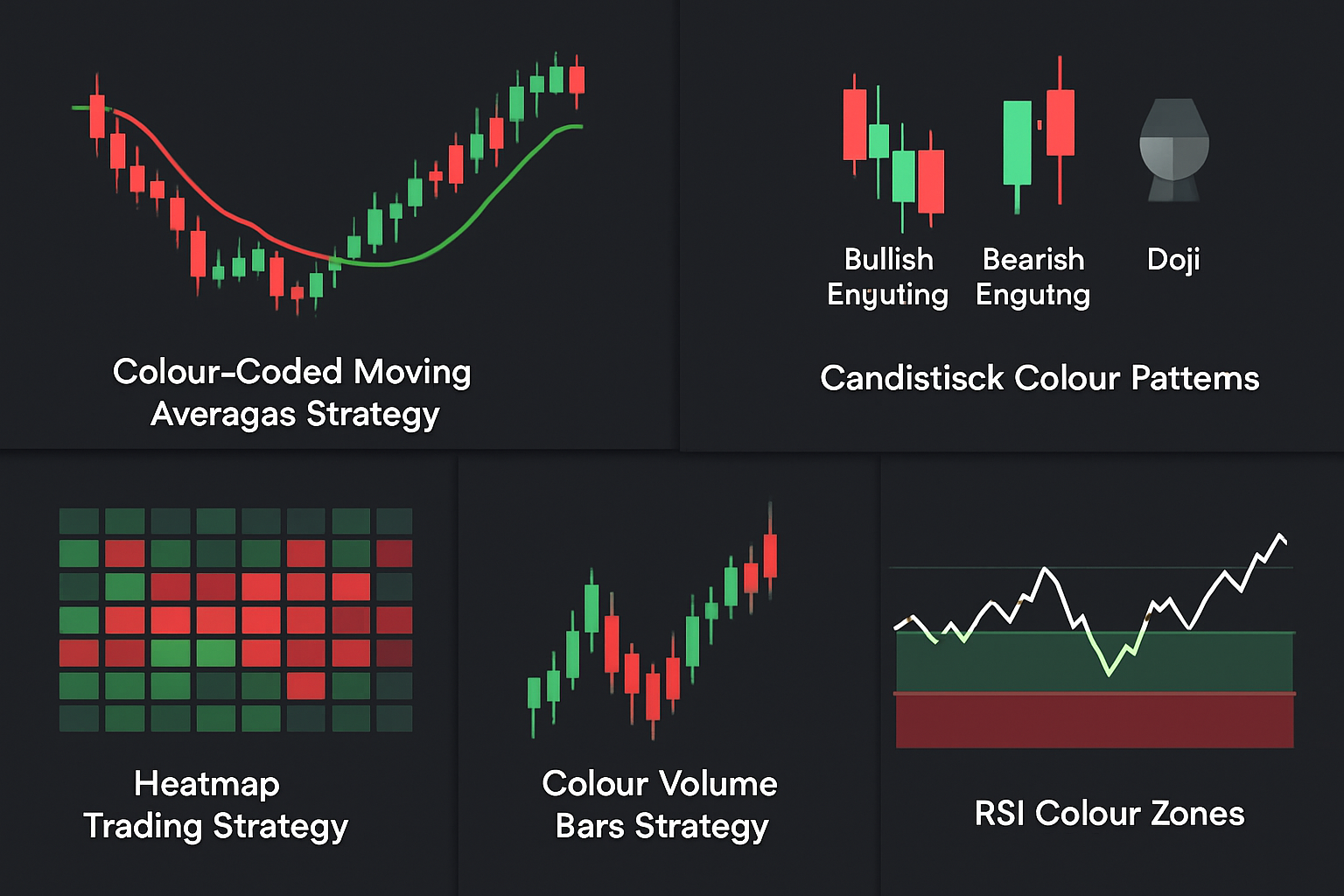
Introduction
Colour trading is a popular technical analysis method that uses color-coded charts and indicators to help traders identify trends, reversals, and key market signals quickly. By interpreting colors on trading platforms, traders can make faster and more informed decisions. This article will explore the top colour trading strategies that consistently deliver results.
Colour-Coded Moving Averages (MA) Strategy
Moving averages smooth out price data to identify trend directions. Colour trading enhances this by assigning different colors to MAs based on their slope or position.
- How it works:
- A green MA line indicates an uptrend.
- A red MA line signals a downtrend.
- When the MA changes color, it alerts traders of potential trend reversals.
- Why it works:
- Visually easy to understand trend changes without analyzing raw price data.
- How to apply:
- Use a fast MA (e.g., 10-period) and slow MA (e.g., 50-period) with color changes to spot crossovers.
- Enter long when fast MA turns green and crosses above slow MA. Exit or short when it turns red.
Candlestick Colour Patterns
Candlestick charts use colors (usually green for bullish, red for bearish) to show price movement within a time frame.
- Key patterns:
- Bullish engulfing: A green candle fully engulfs the previous red candle, signaling upward momentum.
- Bearish engulfing: A red candle engulfs the previous green candle, indicating potential decline.
- Doji candles: Often colored gray or neutral, signaling indecision and possible reversal points.
- Why it works:
- Patterns combine price action and color to provide clear signals on market sentiment.
- How to apply:
- Combine candlestick color patterns with volume indicators for confirmation before entering trades.
Heatmap Trading Strategy
Heatmaps display market sentiment using colors (green = bullish, red = bearish) on multiple assets or timeframes simultaneously.
- How it works:
- Traders scan the heatmap to spot where the strongest buying or selling pressure is.
- Why it works:
- Gives a quick visual overview of the market or sector strength/weakness.
- How to apply:
- Use heatmaps to identify hot sectors or assets before zooming in for detailed analysis.
- Enter trades on assets consistently showing strong green colors.
Colour Volume Bars Strategy
Volume bars are often color-coded to indicate buying vs selling pressure.
- How it works:
- Green volume bars mean buyers dominate that period; red means sellers dominate.
- Why it works:
- Helps confirm price movements; a price rise with green volume bars suggests strength, while red bars during a rise may signal weakness.
- How to apply:
- Use alongside price charts to validate breakouts or reversals. Avoid trades when volume bars show conflicting signals.
RSI Colour Zones
The Relative Strength Index (RSI) can be color-coded to highlight overbought or oversold conditions.
- How it works:
- Green zone for RSI below 30 (oversold) suggests potential buy opportunity.
- Red zone for RSI above 70 (overbought) indicates possible sell or correction.
- Why it works:
- Color zones make it easier to identify entry/exit points at a glance.
- How to apply:
- Combine RSI color zones with trend direction for better accuracy.
- Buy signals are stronger when the overall trend is up and RSI turns green from oversold.
Tips for Successful Colour Trading
- Combine indicators: Don’t rely on a single colour indicator. Use combinations like MA + RSI + volume colors.
- Backtest strategies: Test strategies on historical data to understand their strengths and limitations.
- Stick to your plan: Define entry and exit rules based on color signals and follow them consistently.
- Keep emotions in check: Colors help reduce emotional bias by providing clear visual cues.
- Adjust colors for your platform: Some platforms allow customizing colors for better visibility and personal preference.
Conclusion
Colour trading strategies simplify complex market data into easy-to-understand visual signals, helping traders make faster decisions. The strategies above—moving averages, candlestick patterns, heatmaps, volume bars, and RSI color zones—are proven tools that can enhance your trading success when used properly. Start by mastering one or two, backtest them, and gradually combine them to fit your trading style.
